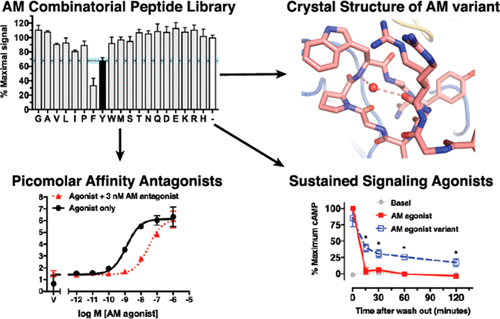当前位置:
X-MOL 学术
›
ACS Pharmacol. Transl. Sci.
›
论文详情
Our official English website, www.x-mol.net, welcomes your
feedback! (Note: you will need to create a separate account there.)
Picomolar Affinity Antagonist and Sustained Signaling Agonist Peptide Ligands for the Adrenomedullin and Calcitonin Gene-Related Peptide Receptors.
ACS Pharmacology & Translational Science ( IF 4.9 ) Pub Date : 2020-07-24 , DOI: 10.1021/acsptsci.0c00031 Jason M Booe 1 , Margaret L Warner 1 , Augen A Pioszak 1
ACS Pharmacology & Translational Science ( IF 4.9 ) Pub Date : 2020-07-24 , DOI: 10.1021/acsptsci.0c00031 Jason M Booe 1 , Margaret L Warner 1 , Augen A Pioszak 1
Affiliation

|
The calcitonin receptor-like class B G protein-coupled receptor (CLR) mediates adrenomedullin (AM) and calcitonin gene-related peptide (CGRP) functions including vasodilation, cardioprotection, and nociception. Receptor activity-modifying proteins (RAMP1–3) form heterodimers with CLR and determine its peptide ligand selectivity through an unresolved mechanism. The CGRP (RAMP1:CLR) and AM (RAMP2/3:CLR) receptors are proven or promising drug targets, but short AM and CGRP plasma half-lives limit their therapeutic utility. Here, we used synthetic peptide combinatorial library and rational design approaches to probe the ligand selectivity determinants and develop truncated AM and CGRP antagonist variants with receptor extracellular domain binding affinities that were enhanced ∼1000-fold into the low nanomolar range. Receptor binding studies and a high-resolution crystal structure of a novel library-identified AM variant bound to the RAMP2-CLR extracellular domain complex explained the increased affinities and defined roles for AM Lys46 and RAMP modulation of CLR conformation in the ligand selectivity mechanism. In longer AM and CGRP scaffolds that also bind the CLR transmembrane domain, the variants generated picomolar affinity antagonists, one with an estimated 12.5 h CGRP receptor residence time, and sustained signaling agonists “ss-AM” and “ss-CGRP” that exhibited persistent cAMP signaling after ligand washout. Sustained signaling was demonstrated in primary human umbilical vein endothelial cells and the SK-N-MC cell line, which endogenously express AM and CGRP receptors, respectively. This work clarifies the RAMP-modulated CLR ligand selectivity mechanism and provides AM and CGRP variants that are valuable pharmacological tools and may have potential as long-acting therapeutics.
中文翻译:

肾上腺髓质素和降钙素基因相关肽受体的皮摩尔亲和拮抗剂和持续信号激动剂肽配体。
降钙素受体样BG类蛋白偶联受体(CLR)介导肾上腺髓质素(AM)和降钙素基因相关肽(CGRP)的功能,包括血管舒张,心脏保护和伤害感受。受体活性修饰蛋白(RAMP1-3)与CLR形成异源二聚体,并通过未解决的机制确定其肽配体选择性。CGRP(RAMP1:CLR)和AM(RAMP2 / 3:CLR)受体已被证明或有望成为药物靶标,但AM和CGRP血浆半衰期短限制了其治疗用途。在这里,我们使用合成的肽组合库和合理的设计方法来探测配体选择性的决定因素,并开发出具有受体胞外域结合亲和力的截短的AM和CGRP拮抗剂变体,其亲和力提高了约1000倍,达到了低纳摩尔范围。受体结合研究和与RAMP2-CLR细胞外域复合物结合的新型文库鉴定的AM变体的高分辨率晶体结构解释了亲和力增加以及AM Lys46和RAMP调节CLR构象在配体选择性机制中的定义作用。在也结合CLR跨膜结构域的更长的AM和CGRP支架中,这些变体产生了皮摩尔亲和性拮抗剂,一种具有估计的12.5 h CGRP受体停留时间,并表现出持续的信号激动剂“ ss-AM”和“ ss-CGRP”配体洗脱后的cAMP信号传导。在原代人内源性表达AM和CGRP受体的原代人脐静脉内皮细胞和SK-N-MC细胞系中证实了持续的信号传导。
更新日期:2020-08-14
中文翻译:

肾上腺髓质素和降钙素基因相关肽受体的皮摩尔亲和拮抗剂和持续信号激动剂肽配体。
降钙素受体样BG类蛋白偶联受体(CLR)介导肾上腺髓质素(AM)和降钙素基因相关肽(CGRP)的功能,包括血管舒张,心脏保护和伤害感受。受体活性修饰蛋白(RAMP1-3)与CLR形成异源二聚体,并通过未解决的机制确定其肽配体选择性。CGRP(RAMP1:CLR)和AM(RAMP2 / 3:CLR)受体已被证明或有望成为药物靶标,但AM和CGRP血浆半衰期短限制了其治疗用途。在这里,我们使用合成的肽组合库和合理的设计方法来探测配体选择性的决定因素,并开发出具有受体胞外域结合亲和力的截短的AM和CGRP拮抗剂变体,其亲和力提高了约1000倍,达到了低纳摩尔范围。受体结合研究和与RAMP2-CLR细胞外域复合物结合的新型文库鉴定的AM变体的高分辨率晶体结构解释了亲和力增加以及AM Lys46和RAMP调节CLR构象在配体选择性机制中的定义作用。在也结合CLR跨膜结构域的更长的AM和CGRP支架中,这些变体产生了皮摩尔亲和性拮抗剂,一种具有估计的12.5 h CGRP受体停留时间,并表现出持续的信号激动剂“ ss-AM”和“ ss-CGRP”配体洗脱后的cAMP信号传导。在原代人内源性表达AM和CGRP受体的原代人脐静脉内皮细胞和SK-N-MC细胞系中证实了持续的信号传导。











































 京公网安备 11010802027423号
京公网安备 11010802027423号